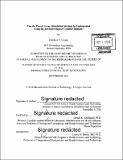Can the phased array stimulation strategy be implemented using the advanced bionics cochlear implant?
Author(s)
Crema, Matthew V
DownloadFull printable version (19.97Mb)
Other Contributors
Harvard--MIT Program in Health Sciences and Technology.
Advisor
Donald K. Eddington.
Terms of use
Metadata
Show full item recordAbstract
Cochlear implants are devices that aim to restore a measure of hearing to the deaf by converting acoustic signals to electric stimuli delivered to electrodes implanted in the inner ear. Theoretically, the phased array stimulation strategy described by van den Honert and Kelsall (2007) provides much better control over the neural excitation patters elicited by electric stimulation by taking advantage of potential field superposition in the implanted cochlea, to construct stimuli for optimally selective excitation of auditory nerve fibers. If the phased array strategy can be implemented using a commonly-implanted commercial cochlear implant system, the strategy could be effectively evaluated in a relatively large sample of patients to determine whether it provides better speech reception than currently available systems. This thesis investigates whether the phased array strategy can be implemented using the Advanced Bionics Clarion CH or HiRes90k cochlear implant. It is shown that for realistic cochlear implant electrode impedance magnitudes, the Advanced Bionics cochlear implant current sources will deliver monopolar current suitable for the necessary measurement of transimpedance with less than 7% error. Transimpedance matrix estimates were obtained in 11 ears in 10 cochlear implant subjects. Measurements reveal that in some test subjects, low impedance current paths exist between implanted electrodes that may cause current leakage through unintended electrodes. Researchers and clinicians should consider using this transimpedance matrix estimation technique to screen for patients or research subjects who could benefit from compensatory changes to their speech processors. The results of this thesis suggest that the phased array strategy can be implemented successfully when the limitations of the internal power supply documented in this document are taken into account. It is recommended that the transimpedance matrix in a given test subject be measured on the day of any psychophysical testing because of the potential impact of variability in transimpedance over time.
Description
Thesis: S.M., Harvard-MIT Program in Health Sciences and Technology, 2016. Cataloged from PDF version of thesis. Includes bibliographical references (pages 179-189).
Date issued
2016Department
Harvard University--MIT Division of Health Sciences and TechnologyPublisher
Massachusetts Institute of Technology
Keywords
Harvard--MIT Program in Health Sciences and Technology.